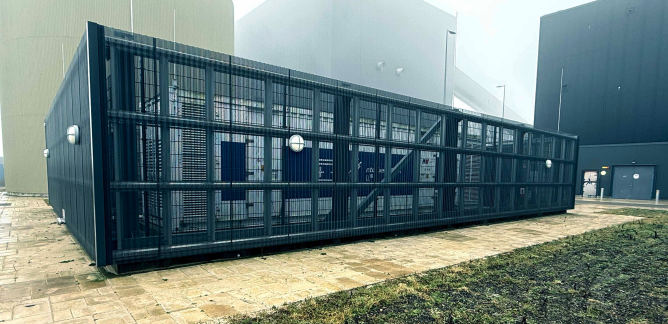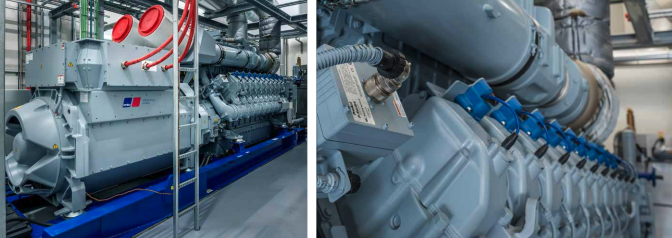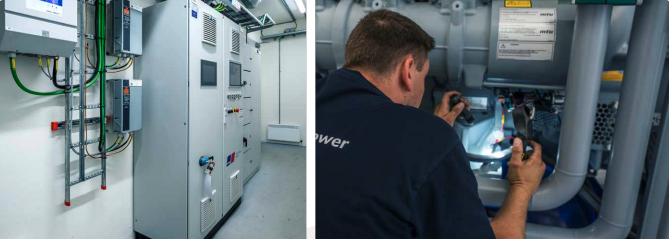
Securing Operations For Din Forsyning
Introduction
BOS Power secures operations for DIN Forsyning with mtu Emergency Power and mtu Energy Storage.
DIN Forsyning was established in 2015 through the merger of utility services from Esbjerg and Varde municipalities in Denmark.
The company provides essential services, including water supply, wastewater management, district heating, and waste collection, serving approximately 185,000 residents.
In 2018, they began transitioning towards more sustainable operations when Ørsted announced the closure of the Esbjergværket, their last coal-fired power plant, which had supplied district heating. The plant officially shut down in August 2024, leaving DIN Forsyning with no choice but to find alternative heating solutions to maintain a stable district heating supply. This necessity became the catalyst for their transition to greener energy sources.
DIN Forsyning is dedicated to sustainability and innovation, ensuring efficient and environmentally friendly utility solutions.

Replacing Coal Power
DIN Forsynings primary challenge was to eliminate coal as an energy source, which previously accounted for 50 % of their supply. Since they needed to establish a new system, they aimed to make it as green as possible.
One of DIN Forsynings main strategies was to diversify energy sources, allowing them to select the most cost-effective option at any given time.
From the beginning, their plan was to comply with district heating regulations, which mandate a maximum of four hours of downtime per year. This meant they had minimal margin for error and needed a system capable of maintaining heat supply even during power outages.
Initially, they considered a diesel-powered backup system for power outages, but they pivoted towards a greener solution using natural gas, which is more sustainable than diesel. Their goal was to integrate biogas into their energy supply chain.

Design And Collaboration
In a pioneering effort to meet complex energy demands, DIN Forsyning collaborated closely with BOS Power and Rolls-Royce to design a multifaceted energy solution that aligned with their specific needs.
More specifically, BOS Power and the Rolls-Royce division Power Systems provided consultancy, conception, order fulfilment, overcame delivery bottlenecks and other challenges.
At the onset of the project, while each technology was well-established individually, their combined operation was still at its early stages. As separate units, the understanding and insights into their individual functional features was great. Integrating them was a first and demanded a lot from the manufacturer, system integrator and costumer, to ensure everything was properly aligned, defined and tested.
The workflow from early tender phase into offering and final negotiation was made in a classic sense following the rules and guidelines for any tender process.
The differentiator was the contract phase, where there over the course of a couple of days was conducted physical meetings with the purpose of aligning and explaining the content, the scope and the overall work in as many details as need for all involved to be synchronized on the project.
This process has widely contributed to a common unified understanding of the scope and deliverables, minimizing the deviations commonly seen on projects of this size.
Any deviations and variations were subsequently discussed during execution and delivery, and those accepted was in turn transformed into variation orders handled by the delivery team as an extension or change of scope.

Advantages & Benefits
The collaboration with BOS Power and Rolls-Royce provided DIN Forsyning with several benefits and operational efficiencies.
One of the most important advantages of the solution is that it will fulfill various functions: backup power, heat and grid services.
As mentioned, DIN Forsynings primary challenge was to eliminate coal and by doing so, transition to greener energy sources. This system offers a substantial environmental improvement over traditional diesel-battery solutions, achieving a remarkable Combined Heat and Power (CHP) efficiency of up to 99,9 %. It simultaneously generates electricity and heat, enhancing both efficiency and sustainability
Additionally, the mtu gas generators are H2-ready, and DIN Forsyning can operate their system in a CO2-neutral way with green hydrogen in the future. An innovative feature of the system is the efficient reuse of heat. Designed to maximize fuel usage, the system captures excess heat from two primary sources: the engine cooling and exhaust systems. This high-volume hot exhaust gas and other heat are funneled through a heat exchanger, transferring the captured energy into hot water. This hot water is then circulated through the heat exchanger, providing effective cooling for both the engine and the exhaust, thereby enhancing the overall efficiency and sustainability of the operation.
Another key achievement is compliance with strict district heating regulations, which stipulate a maximum of four hours of downtime per year. This reliability, combined with the generation of additional financial returns through Frequency Containment Reserve (FCR) revenues, is achieved without incurring substantial operational costs.
The hybrid energy setup enables DIN Forsyning to monitor market prices and ensure cost-efficient heat production for consumers. One goal was to transition from coal to a flexible energy mix, optimizing heating costs across seasons through real-time monitoring and automated quarterly adjustments.

Collaborative Partnership Conclusion
The success of the collaboration between BOS Power, Rolls-Royce, and DIN Forsyning stems from a strategic focus on project-based and technology-driven solutions.
Key lessons underscored the necessity of continuous dialog, close collaboration, and transparency to effectively minimize challenges during execution. Notably, transparency plays a critical role as it ensures that all parties involved receive timely and accurate information on any matters that may require clarification.
This innovative solution, which merges BESS technology with gas gensets, represents a pioneering step towards harnessing today’s technology to address tomorrow’s challenges.
The delivery consisted of:
- Project management, installation, commissioning
- Battery Energy Storage System (BESS)
- mtu combined heat and power plant (2.5 MW)
- mtu gas genset powered by a mtu 20V 4000 L64 FNER engine
- Heat recovery unit
- Oxidation catalyst for the exhaust gas aftertreatment
- mtu EnergyPack battery solution (1250 kVA/ 1068 MWh)
- mtu microgrid controller for the control system

“The process was challenging, but we are very satisfied with the final result. BOS Power has been a professional and reliable partner throughout the entire project, delivering on their commitments. Trust is a key element in our partnerships, and BOS Power, including Jess, Jesper, and the rest of the team, has met our expectations.”

“This solution, combining the technology from BESS and gas gensets, is a first step towards leveraging the technology available to solve a challenge of tomorrow by using the technology of today. Choosing this approach shows that a more green and multipurpose solution is available to solve the needs for continuous operation.”

“What worked particularly well was working together to develop and implement a solution that precisely meets the customer’s specific needs – opening new opportunities for the combination of the two technologies BESS and gas genset.”
Get in Touch
Do you want to learn more about our solutions or discuss how we can support your next project? Our team of experts is ready to answer your questions and explore opportunities together.- Let’s talk about your needs
- Share your ideas with us
- Start building a sustainable and reliable future today